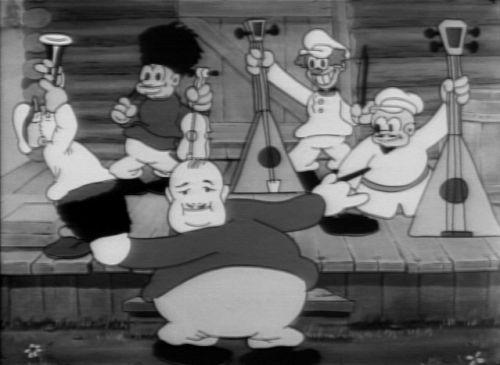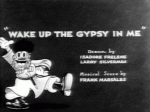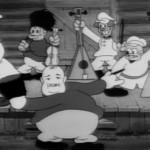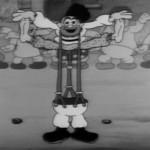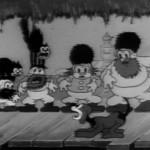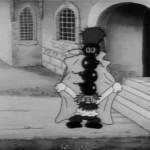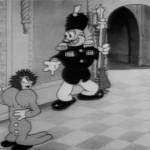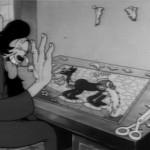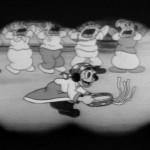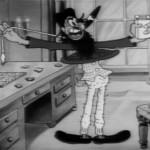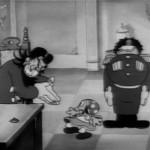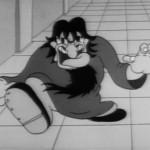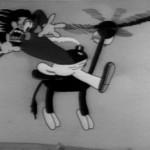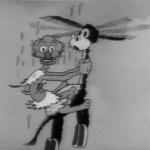Credits: Supervision by – Rudolf Ising Summary: Rice-Puddin’ the mad monk kidnaps a gypsy girl and attempts to have his way with her. Description: The setting is a gypsy village in Russia, where the peasants are performing traditional Cossack dances to not-so-traditional music. Their band is led by a Paul Whiteman caricature, and we see that their balalaika player can play his instrument with a herring! One of the dancers jumps out of his pants, and a quartet of men gurgle to the music. Another quartet of men is seen pulling a rope, which seems to be a heavy burden. Suddenly the men do a dandy step, and we see what’s at the end of the rope: a little dog! One man cranks his ear to tune his voice, and he then reveals three other men behind him as they all break out into the title tune. This unusual quartet has the uncanny ability to grow larger or smaller depending on the direction they face. When a dog appears, their hats turn into cats which hiss at the confused dog and scare him off. A young gypsy girl appears and begins dancing with a tambourine. At the conclusion of the song, we spy upon an unusual-looking cloaked stranger as he sneaks away from the festivities and towards the palace. He is momentarily revealed to be a very short peasant with four cannonball-like fuse bombs on his head; he is apparently preparing to start a revolution. A title card appears which reads “Rice-Puddin’ — The Mad Monk”. We see that Rice-Puddin’ is occupied by a jigsaw puzzle, and that he cheats by using scissors to cut the pieces into the right shapes. The stranger sneaks by a palace guard by using two of the bombs as breasts, thus turning himself into a voluptuous beauty who can get by with no questions asked. Rice-Puddin’, still working on the puzzle, is unable to fit a certain piece, so he cuts up a picture of the czar into the appropriate shape. It is revealed that the puzzle is of a horse, and that the czar’s head is the piece that goes on the horses’ ass! Rice-Puddin’ takes out a pair of binoculars and takes a close look at the festive gypsies. “Bah! The fools!” he shouts, but soon he spots the young gypsy girl and a devilish smile appears on his face. He turns to a guard and says “You get for me little girl, eh?”. Rice-Puddin’ pulls a cigar off the guard’s uniform, and the guard goes off to do his dirty deed. Rice-Puddin’ sniffs the cigar, tugs on a string which lifts his robe and reveals his underwear, then takes a lighter from his shirt pocket. The lighter is, of course, a mouse with a match. He puffs away impatiently, but soon the guard returns with the girl. After eyeing her for a moment, Rice-Puddin’ presses a button which sends the guard down a trap door, thus leaving him alone with the girl. “Give old maestro big kiss, eh?” he says, but the girl pooh-poohs the notion. He begins to chase her around the room and soon manages to corner her, but her cries for help are answered by a mob of angry (and armed) gypsy peasants. “Holy mackerel! Revolution!” he shouts, and then leaves the girl behind as he tries to escape with his life. He hops onto a donkey and makes a run for it, but the gypsies catch up to him and — without him noticing — drop a bomb in his pants! The gypsies break off their attack and leave Rice-Puddin’ to believe that he can make a clean getaway. He cranks his donkey’s tail, which turns the animal into a helicopter that sends them soaring into the air. It is then that Rice-Puddin’ notices the bomb in his pants, but it’s too late. The bomb explodes, and when the smoke clears we see Rice-Puddin’ turned into a caricature of Mahatma Ghandi, and we iris out. “So long, folks!” Notes:
Memorable Scenes: Video Availability: Laserdisc: Golden Age of Looney Tunes, Vol. 3
|
